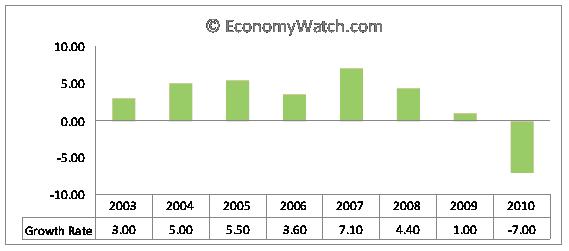South Africa Industry Sectors
Please note that we are not authorised to provide any investment advice. The content on this page is for information purposes only.
South Africa unveiled its new industrial policy in February 2010 to specifically target capital goods, transportation equipment and metal fabrication, aiming to boost manufacturing capacity and increase employment. South African government officials are hoping that this new industrial policy will add more than 500,000 jobs in the sectors badly hurt by the recession of 2008-09. The following chart illustrates South Africa’s industrial production growth rate during 2003-2009, and the forecast rate for 2010. All data are in percentages.[br]
South Africa unveiled its new industrial policy in February 2010 to specifically target capital goods, transportation equipment and metal fabrication, aiming to boost manufacturing capacity and increase employment. South African government officials are hoping that this new industrial policy will add more than 500,000 jobs in the sectors badly hurt by the recession of 2008-09. The following chart illustrates South Africa’s industrial production growth rate during 2003-2009, and the forecast rate for 2010. All data are in percentages.[br]
South Africa Industries: Mining
The mining industry in South Africa is a pillar of the nation’s industrial structure. It is the fifth largest contributor to the GDP. This industry is the country’s largest employer, and the industry’s expertise is globally recognized. However, due to the global recession, the mining industry experienced a series of disastrous events, such as a fall in commodity prices and consumer demand. This led to production cuts and cutbacks on major projects.
Mining production fell alarmingly in 2009 after the highs of January 2005. Mineral sales dropped 30% between October 2008 and October 2009. The increased levels of production, however, between October 2009 and November 2009 are hopefully a sign for more optimism in this sector. The turnaround for this industry has been attributed to a gradual rise in oil and commodity prices worldwide, weakening of the US dollar, and the resurgence of the Chinese economy.
The outlook in 2010 for this sector will hinge on the growth of global demand of minerals in China and other emerging markets. It will also depend on the slow recovery of the US and European economies, as these regions are South Africa’s major export partners.
According to Frost and Sullivan, the challenges for the mining industry include shortages in electricity supplies, and skills and safety concerns. The recovery of commodity prices, particularly for gold, platinum and coal, is also likely to lead to increased wage demands from the labor unions.[br]
South Africa Industries: Tourism
South Africa’s natural beauty, magnificent outdoor life, good climate and cultural diversity have made the country an ideal destination for foreign tourists. International travel to South Africa has increased manifold since the ban on apartheid policies in the early 1990s. This sector is also a major contributor to the GDP. Whether it is business tourism, cultural tourism, eco-tourism, paleo tourism, adventure tourism or sports tourism, South Africa has something for everyone.
South Africa’s sports tourism sector has blossomed in recent times. Due to numerous sporting tournaments like the 1995 Rugby World Cup, the 2003 Cricket World Cup, the Women’s World Cup of Golf 2005-2008, the inaugural World Twenty20 Cricket Championships in 2007, and the A1GP World Cup of Motorsport, held in Durban in 2006, 2007 and 2008, this sub-sector has emerged at the forefront of the tourism industry. Now the country is gearing up for millions of tourists for the FIFA World Cup in June and July 2010.





